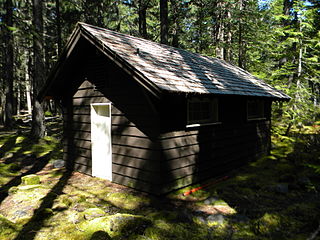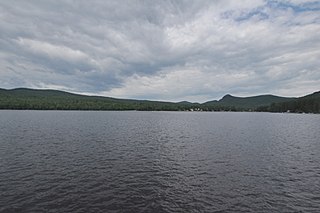
Wilgus State Park is a state park in Ascutney, Vermont. The park offers canoeing along the Connecticut River and hiking up the Pinnacle Trail. The park has tent and lean-to sites and is quite close to Mount Ascutney and the Saint-Gaudens National Historic Site. The park was originally constructed by the Civilian Conservation Corps (CCC) and is now administered by the Vermont Department of Forests, Parks, and Recreation as part of the Vermont state park system. It is named after William J. Wilgus, who donated the land for the park in 1933. The park is listed on the National Register of Historic Places for its well-preserved CCC infrastructure.

Rim Village is the main area for tourist services in Crater Lake National Park in southern Oregon, United States. It is located on the southwest rim of the caldera overlooking Crater Lake. The National Park Service designed Rim Village to concentrate park services at a location that provided easy access to rim trails and view points. Because of the unique rustic architecture of the Rim Village structures and the surrounding park landscape, the area was listed as Rim Village Historic District on the National Register of Historic Places in 1997.

The Roes Creek Campground Camptender's Cabin, also known as the Rising Sun Campground Ranger Cabin, in Glacier National Park is an example of the National Park Service Rustic style.

The Many Glacier Campground Camptender's Cabin in Glacier National Park is an example of the National Park Service Rustic style. Built in 1934, the small cabin is significant for its association with park visitation patterns, auto camping, and NPS rustic architecture.

The Saddlehorn Comfort Station is one of a group of related structures listed on the National Register of Historic Places in Colorado National Monument. The comfort station and the nearby caretaker's house, garage and the Saddlehorn Utility Area Historic District feature a consistent interpretation of the National Park Service Rustic style, featuring coursed ashlar sandstone masonry and log-supported roof structure. The comfort station was designed in 1936 by W.G. Carney of the National Park Service Branch of Plans and Designs, and built by labor from the Works Progress Administration and the Civilian Conservation Corps. Plans specified not only the general layout of the house and garage, but the specific dimensions of each stone and its location, using a technique of "built by detail".

The Glacier Basin Campground Ranger Station in Rocky Mountain National Park was built in 1930 to a design by the National Park Service Branch of Plans and Designs. The National Park Service Rustic log and stone structure was designed to blend with the landscape, and continues to function as a ranger station.

The Timber Creek Road Camp Barn was built in 1931 to support the construction of Trail Ridge Road in Rocky Mountain National Park. The design is attributed to Thomas Chalmers Vint of the National Park Service Branch of Plans and Designs. The barn was moved in 2002 and used for storage. It was listed on the National Register of Historic Places in 1987, and was delisted in 2022.

The historical buildings and structures of Zion National Park represent a variety of buildings, interpretive structures, signs and infrastructure associated with the National Park Service's operations in Zion National Park, Utah. Structures vary in size and scale from the Zion Lodge to road culverts and curbs, nearly all of which were designed using native materials and regional construction techniques in an adapted version of the National Park Service Rustic style. A number of the larger structures were designed by Gilbert Stanley Underwood, while many of the smaller structures were designed or coordinated with the National Park Service Branch of Plans and Designs. The bulk of the historic structures date to the 1920s and 1930s. Most of the structures of the 1930s were built using Civilian Conservation Corps labor.
The Sunrise Comfort Station (S-310) is a comfort station in Mount Rainier National Park, Washington, USA. Built around 1930, the building was designed by Thomas Chalmers Vint of the National Park Service in association with landscape architect E.A. Davidson. The structure was part of a planned ensemble at what was then called Yakima Park, high on the northern flank of Mount Rainier. Similar structures may be found at the Ohanapecosh, Longmire and White River campgrounds in the park. The low building is framed in peeled logs on a stone foundation, set into a hillside and surrounded by native landscaping.

The Longmire Campground Comfort Stations were built in the early and mid-1930s in Mount Rainier National Park to provide public toilet facilities to automobile tourists camping in the park at Longmire. Essentially the same in design, the facilities were designed by the National Park Service Branch of Plans and Designs. Their construction was supervised by park landscape architect Ernest A. Davidson. The timber-frame buildings followed the tenets of the prevailing National Park Service Rustic style.

The Elwha Campground Community Kitchen was built in Olympic National Park to serve the Altair Campground. It is an open octagonal shelter built in 1935 by the Civilian Conservation Corps personnel from the Elwha River Camp in the National Park Service Rustic style. The peeled log structure is capped with a cedar shake roof, enclosing a cooking fireplace and chimney. The Elwha and Altair Campground Community Kitchens are the only such structures remaining in Olympic National Park.

The Loop C Comfort Station and the Loop D Comfort Station are public toilet facilities in Bryce Canyon National Park's North Campground, individually listed on the National Register of Historic Places in 1995 for their significance as structures relating to the park's administrative infrastructure, and for their integrity as examples of rustic architecture. The National Park Service rustic style structures were built in 1935 as part of the first planned campground in the park by Civilian Conservation Corps labor. Plans were developed by the National Park Service Branch of Plans and Designs. Similar facilities in Loops A and B were not built until the 1950s.
Architects of the National Park Service are the architects and landscape architects who were employed by the National Park Service (NPS) starting in 1918 to design buildings, structures, roads, trails and other features in the United States National Parks. Many of their works are listed on the National Register of Historic Places, and a number have also been designated as National Historic Landmarks.
Harry Langley was an architect of the National Park Service. He was born in England. He retired in 1957.

The Crowley's Ridge State Park Comfort Station is a historic visitor facility at Crowley's Ridge State Park, in Greene County, Arkansas. Located in the campground section of the park, it is a single-story log structure with a gable roof, in which are latrine facilities. It was built c. 1933 by a crew of the Civilian Conservation Corps, and is a well-preserved example of the Rustic style architecture the CCC popularized.

Blackwoods Campground is located on the east side of Mount Desert Island, off Maine State Route 3 in Acadia National Park. Construction on the site was begun by the Civilian Conservation Corps (CCC) in 1935, and reaching its present appearance around 1961, with the completion of Loop B. The campground has 306 individual campsites, several group campsites, and offers only limited amenities, which include potable water and restrooms, but not showers or electrical hookups. Campsites may be reserved up to six months in advance. The portion of the campground built by the CCC, which includes its core and Loop A, was listed on the National Register of Historic Places in 2007.

Seawall Campground is a campground in Acadia National Park on Mount Desert Island off the coast of Maine. The campground offers four loops of campsites, including "drive-up" sites suitable for RVs and trailers, as well as walk-in tent-only campsites, and is open from late May into October. Much of the campground was built between 1936 and 1942 by crews of the Civilian Conservation Corps; this section is listed on the National Register of Historic Places. The campground is located in the village of Seawall, in the town of Southwest Harbor on Maine State Route 102A.

Townshend State Park is a state park in Townshend, Vermont. Embedded within Townshend State Forest, the park provides a camping facility and hiking trails for accessing Bald Mountain. The park's facilities were developed by the Civilian Conservation Corps in the 1930s, and are listed on the National Register of Historic Places for their well-preserved state.

Gifford Woods State Park is a state park located at the base of Pico Peak in Killington, Vermont. The wooded park provides camping, picnic, and fishing facilities, and has hiking trails, including a portion of the Appalachian Trail. It preserves an area of old-growth forest that has been designated a National Natural Landmark, and is accessible via an interpretive trail. The park was established in 1931. Part of it is listed on the National Register of Historic Places, for facilities developed by the Civilian Conservation Corps in the 1930s.

Stillwater State Park is a state park located on Lake Groton in Groton, Vermont. The park is located in Groton State Forest close to the Groton Nature Center, Boulder Beach State Park and Big Deer State Park. The park offers camping, picnicking, and access to water-related activities on Lake Groton. The park was developed in the 1930s by crews of the Civilian Conservation Corps (CCC). It is open to the public between Memorial Day weekend and Columbus Day weekend; fees are charged for day use and camping.



















